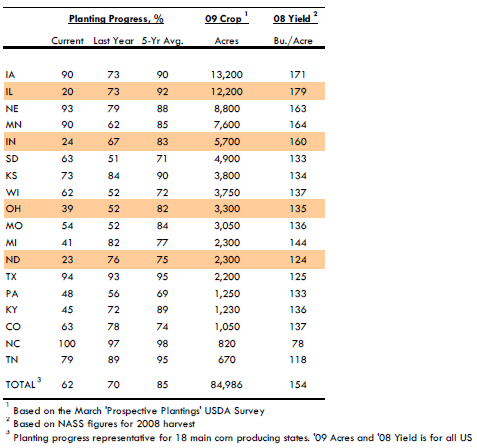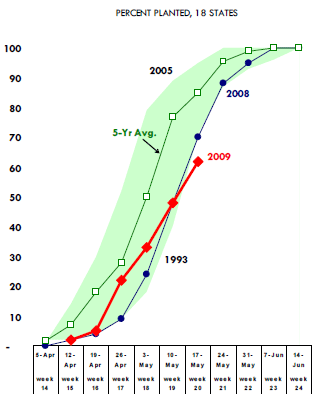



CME: USDA Report Reveals Low Corn Crop Planting
US - CME's Daily Livestock Report for 18 May 2009 reports that excessive moisture in the Eastern Corn Belt continues to hamper corn plantings.The situation is particularly troubling in Illinois and Indiana, two states which according to the March ‘Prospective Plantings’ report are expected to plant 21 per cent of the entire US corn crop.
In addition to planting a significant number of the corn acres for 2009, these two states also account for some of the best corn yields in the country. USDA data for 2008 shows that the Illinois corn crop had an average yield of 179 bu./acre, compared to the national average of 154. Indiana yields were also well above the national average. Much of the talk in the marketplace at this point has focused on the impact that the delays in plantings will have on yields. But there is also the risk that farmers who are very behind on their plantings may eventually switch to soybeans, induced in part by the recent surge in soybean futures.
The latest USDA crop progress report showed that as of 17 May, only 62 per cent of the US corn crop had been planted. This was 8 percentage points below the relatively late crop planted in 2008 and some 23 percentage points below the five year average. In Illinois, only 20 percent of the corn crop has been planted so far, compared with 92 per cent that on average is planted by this time of year. Similarly, just 24 per cent of the corn crop has been planted in Indiana, compared to 67 per cent a year ago and 83 per cent for the five year average.
The market has yet to become extremely concerned with the delays in plantings in part because of the experience of a year ago. Corn planting was also delayed last year but the final corn yield came in almost exactly as what was projected in the May 2008 report. Still, there are good reasons to be worried this year. As the attached table shows, the delays in critical corn producing areas this year are much more significant than a year ago. Corn futures continue to hold a somewhat bullish tone at the moment but the market has yet to go into full panic mode because of reports that moisture conditions are expected to improve significantly in the next couple of weeks with an extended dry period expected to develop across much of the Eastern Corn Belt. This should allow producers to quickly catch up but fields have to dry up first and all we have at the moment are forecasts of good weather, not the real thing.
Bottom line: The current corn crop is critically behind. The latest USDA report showed that 2009/10 corn stocks are especially tight and any significant production disruptions this summer could be very bullish for grain prices and negatively impact livestock producer returns.
US Corn Crop Progress: week ending 17 May, USDA










